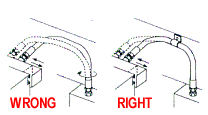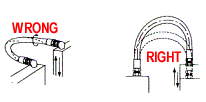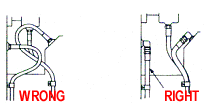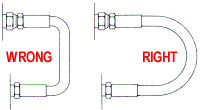Proper
hose installation is essential for satisfactory performance.
If hose length is excessive, the appearance of the installation
will be unsatisfactory and unnecessary cost of equipment
will be involved. If hose assemblies are too short to
permit adequate flexing and changes in length due to expansion
or contraction, hose service life will be reduced.
The following diagrams show proper hose installations
which provide maximum performance and cost savings. Consider
these examples in determining length of a specific assembly. |
 |
When hose installation is straight, allow enough
slack in hose line to provide for length changes which
will occur when pressure is applied. |
 |
Adequate hose length is necessary to distribute
movement on flexing applications and to avoid abrasion. |
 |
Avoid twisting of hose lines bent in two planes
by clamping hose at change of plane. |
 |
Reduce number of pipe thread joints by using proper
hydraulic adapters instead of pipe fittings. |
 |
When radius is below the require minimum, use
an angle adapter to avoid sharp bends. |
 |
Use proper angle adapters to avoid sharp twist
or bend in hose. |
 |
Prevent twisting and distortion by bending hose
in same plane as the motion of the boss to which hose
is connected. |
 |
Route hose directly by using 45 inch and/or 90
inch adapters and fittings. Avoid excessive hose length
to improve appearance. |
 |
To allow for length changes when hose is pressurized,
do not clamp at bends so that curves will absorb changes.
Do not clamp high and low pressure lines together. |
 |
High ambient temperatures shorten hose life so
make sure hose is kept away from hot parts. If this is
not possible, insulate hose. |
 |
To avoid hose collapse and flow restriction, keep
hose bend radii as large as possible. |
 |
When installing hose, make sure it is not twisted.
Pressure applied to a twisted hose can result in hose
failure or loosening of connections. |
 |
Elbows and adapters should be used to relieve
strain on the assembly, and to provide neater installations
which will be more accessible for inspection and maintenance. |
 |
Run hose in the installation so that it avoids
rubbing and abrasion. Often, clamps are required to support
long hose runs or to keep hose away from moving parts.
Use clamps of the correct size. A clamp too large allows
hose to move inside the clamp and causes abrasion. |

